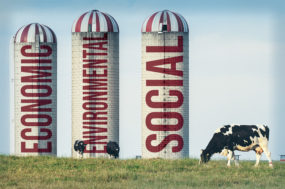Heat and its partner, humidity, coupled with other factors in the late summer months, such as new forages entering the rations and less time to work with cows, make summer the most challenging time for producers to get their cows in calf.
To keep pregnancy rates up during the summer months, focus on ways to maintain both insemination and conception rates. One obvious way is to cool your cows.
There are a variety of barn designs, fan makes and sprinkler systems that can help accomplish this goal. However, even the barns with the best cooling systems can still have cows that experience heat stress, making it necessary to deploy other strategies.
Keeping transition cows cool and comfortable is key to your reproductive program. As the most important group in your breeding program, you know that a cow that goes through a positive transition has an increased chance of getting pregnant.
Successful transition cow programs keep dry matter intake (DMI) up in both the pre-calving and post-calving stages.
During the summer months, this becomes even more important as the spoilage accompanying rising temperatures causes the ration’s palatability to drop.
To help combat this, you may want to consider delivering rations more than once a day, controlling DMI and reducing spoilage.
Also, the common practice of delivering dry cow rations every other day is not recommended during the summer months, as the ration’s palatability will drop on day two. Reducing spoilage and cooling the cows at the bunk will help ensure the DMI stays up and that the cows keep ruminating.
Calving ease sires should be looked at more closely for those cows and, especially, your heifers scheduled to calve during the summer months.
Carefully choosing these ideal mating sires in October and November will help your herd get off to the best start possible as they enter the milking line, the transition period and it will put them in good shape to breed 60 days later.
Also, combat uterine infections by making sure calving areas are kept clean. Bacteria grow faster in summer temperatures and infections such as metritis can quickly lower your cows’ future fertility.
Measuring the influence of summer stressors on your cows’ health and reproductive performance is important. A great practice is to measure the following diseases year-round and then see if there’s an increase in the warmer months: retained placenta, ketosis, displaced abomasum, metritis and mastitis.
Another simple way to assess your reproductive program’s effectiveness during the summer months is to look at first-service conception rates by month fresh.
This figure gives you a rough estimate of how well your cows that freshened in the summer fared when it came time to breed them.

Chances are, if your herd is having first-service conception problems in fall months (see Table 1), it can be linked back to transition cow issues during the summer months.
Heat detection is one of the more common challenges summer temperatures present.
When cows are heat-stressed they show fewer visible heat signs, with some cows having silent heats and others not cycling at all. This results in a drop in insemination rates.
The best way to assess your herd’s heat detection rate in the summer is to monitor the 21-day insemination rate, making sure it does not drop as temperatures increase.
Setting a goal to maintain a herd insemination rate of 60 percent during the summer months will help ensure that no open cows slip through the cracks.
No matter what is happening in the field and elsewhere during the summer months, it is very important to maintain regular herd health checks, identifying open cows and taking action to get them pregnant.
Not staying on top of your open cows during the summer months will certainly have a negative impact on your days in milk in the fall and winter months.
A good idea to help you find those cows you are not seeing in heat is to discuss possible timed A.I. (TAI) or electronic heat detection systems with your veterinarian, as these systems will help you find cows you are missing.
Herds already using a mix of heat detection and TAI for cows that haven’t shown any signs of estrous don’t normally see their insemination rates drop during the summer months.
However, for these herds a number worth checking is the ratio of visual and/or activity monitoring breedings versus TAI breedings by month.
Most herds see some degree of increased TAI during the summer months and, in some cases, this shift can be striking.
For example, a herd that normally breeds 25 percent TAI during the winter months may suddenly notice TAI breedings jump to 50 percent in the summer months.
If your herd has a dramatic increase in TAI usage during the summer, it could be a sign that your cows are heat- stressed and it may be worth investing in more cooling equipment.
Keeping pregnancy rates up during times of heat stress involves more than just cooling cows. Do the following to help ensure your herd’s reproduction doesn’t fall behind this summer:
Keep conception rates up through the summer and fall by keeping DMI intake up, especially with your transition cows.
Pay extra attention to calving eases when choosing mating sires on your heifers in October and November – this will help facilitate better transitions in the summer months.
Monitor insemination rates to make sure they don’t slip when temperatures rise and watch to see what breeding tools are being used during the summer. PD

- Mark Carson
- Reproductive Strategy Manager
- EastGen







